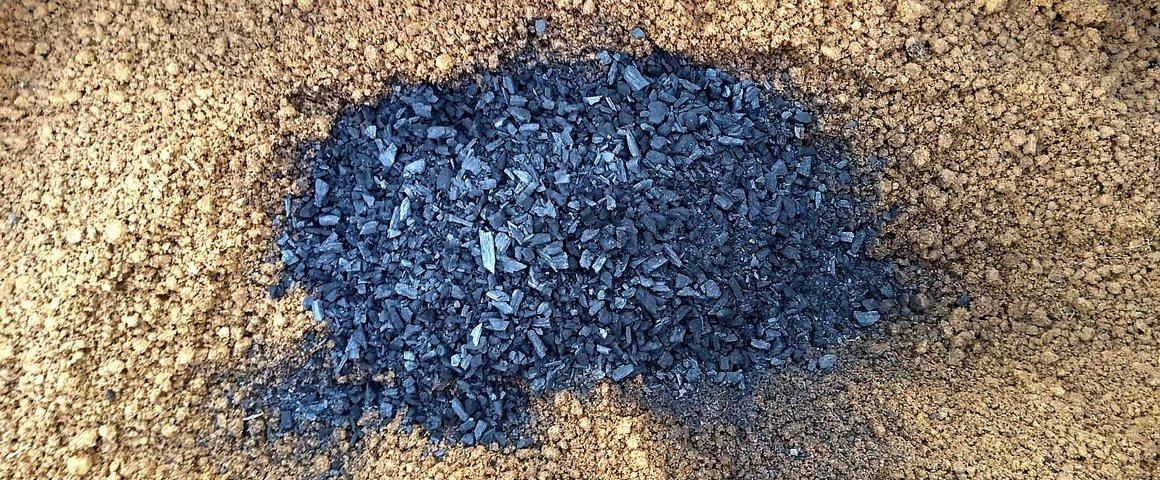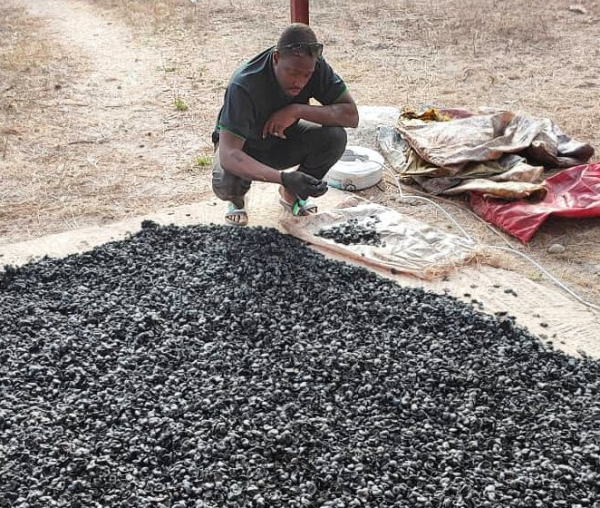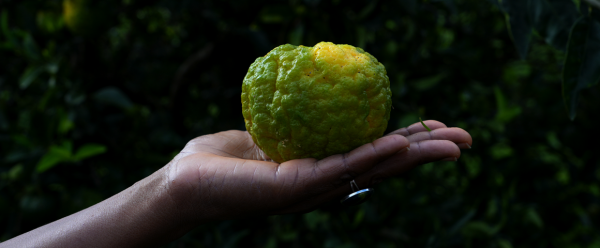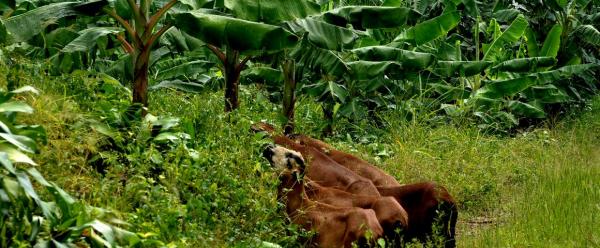Science at work 19 December 2025
- Home
- CIRAD news
- News
- Is biochar a miracle product?
Energy, carbon capture and soil restoration: is biochar a miracle product?

Biochar was already used in the Amazon more than 2000 years ago. It is now being rediscovered as a lever for mitigating climate change © L. J. Parra Serrano, UFMA
Biochar is pure carbon that remains stable over time. What better way of storing atmospheric CO2 than in this concentrated, inert form? The IPCC has even classed biochar as one of the negative emission technologies that will be vital if we are to have a chance of keeping global warming below 1.5°C.
Biochar can be made by heating any plant matter, without oxygen, to between 300 and 700 °C, a reaction known as pyrolysis or carbonization. The charcoal used for barbecues, for instance, can be described as biochar. However, the material has many other applications in addition to energy production. If dug into the soil, it improves its structure, reduces acidity, retains water at root level and even helps control certain insect pests that attack crops. Biochar also has excellent filtration and decontamination properties, once activated to make it more porous. It can therefore also be used to make water drinkable or to filter sewage farm sludge.
30 years of globally recognized expertise in biochar and its applications
CIRAD has been an expert in biochar for more than 30 years. "At the time, we were biomass energy research pioneers", CIRAD's Patrick Rousset, a researcher specializing in fuelwood, explains. "It is that long experience that has made us universally recognized as experts in biochar production processes and characterization."
"Our expertise ranges from the industrial scale to small, independent processing units suitable for rural situations in the global South, making biochar from crop waste", Alfredo Napoli, a process engineering researcher with CIRAD, adds. "It also extends to our agronomist colleagues conducting field trials to test the impact of biochar applications on crop productivity, soil structure, soil biology, etc." Thanks to this multidisciplinary expertise and the growing popularity of biochar, CIRAD is involved in a multitude of very varied projects expected to give rise to applied research.
Producing energy that sequesters carbon
On average, a biomass pyrolysis reaction produces 30% biochar and 70% highly polluting gases that can, and indeed should, be burned to produce energy. That energy can in turn be partly used to fuel pyrolysis operations. This accounts for the carbon capture potential of the carbonization reaction, and explains why it is one of five possibilities being studied by the CRONUS project. The aim of this Horizon Europe project (2022-2026) is ambitious but is the stuff that dreams are made of: producing energy with a negative overall carbon footprint. That energy would be produced from biogenic gases, in other words gases produced from biomass, to make use of the CO2 stored by plants thanks to photosynthesis. Alfredo Napoli is in charge of the pyrolysis component of the Cronus project. "This is a concept that works, we know that, but it is only currently operational on an industrial scale, using wood. The idea is to be able to apply it autonomously, on a case-by-case basis, depending on the biomass residues available, capacities, and requirements."
Making crop residue into biochar…
As part of a circular economy, agricultural waste can be a real goldmine. This is the assumption behind the EU Bio4Africa project (2021-2025). "We have developed a biochar production process in partnership with the Federal University of Viçosa in Brazil, for three purposes: improving agricultural soils, producing fuel briquettes and developing charcoal filters to purify water", Patrick Rousset explains. This last application is the topic for a thesis Landry Koffi is currently writing at CIRAD. "I am looking for processes that farmers could easily take on board to produce biochar in Africa", says the PhD student, who is currently testing biochar made from groundnut shells and cocoa pods.
… for a circular economy
In Madagascar, the EU DINAAMICC project, funded under the DeSIRA programme, is coordinated by CIRAD. It is working with the Ceffel, a Madagascan experimentation and training centre that has begun studying biochar. "It all began with a need expressed by producers belonging to FIFATA, a farmers' organization, to make better use of rice husks, a form of crop residue available in large quantities", says Ceffel Director Andry Rasamimanana. "Producers have tried to make compost and vermicompost, but rice husks do not break down easily. Given the need to improve soils, we thought of using them to make biochar." The usual way of getting rid of piles of rice husks is to use them as a fuel, for instance in brick ovens, and then to use the ash as a soil amendment. However, this is not as good for the soil as biochar applications, not to mention the fact that it emits carbon rather than capturing it.
"Like all innovations, studies are required to establish technical and economic references, in order to offer producers a real decision support tool", Andry Rasamimanana adds. "Hence our close collaboration with CIRAD and the FERT agricultural agency to characterize the biochars produced and improve pyrolysis methods, so as to pollute less and produce more."
Alain Ratnadass is an agricultural entomologist with CIRAD. He is looking into another potential application for silica-rich biochars: protecting crops against pests, and has coordinated a review of the literature on the topic. After promising tests in the laboratory and greenhouse, in partnership with FOFIFA and the University of Antananarivo and funded by the EU, the Regional Council and the Préfecture in Réunion, field trials are due to begin in Madagascar and Réunion.
In Réunion, another project looking at biochar began recently. EcoPAL is funded by ADEME, and set out to test biochar production from palette wood, for use as an agricultural substrate. The first tests were completed last month. The next step is to characterize the biochar produced and analyse the relevance of the value chain for the island.
Biochar to restore degraded soils…
The FENIX project (Turning bio-waste into a soil amendment product) is supported by the European Commission Horizon Europe programme. It intends to use bio-waste to make soil amendment products that will boost agricultural soil fertility while sequestering carbon.
"The project is really exciting, because it combines three major goals for humanity: improving agricultural production by making degraded soils fertile again, fighting climate change, and making virtuous use of organic waste, which is environmentally harmful if it is not recycled", says François Pinta, a CIRAD researcher who is in charge of the project within CIRAD's BioWooEB research unit. The amendment the FENIX project is hoping to produce mixes biochar with digestate, a by-product of biomethane production. CIRAD is in charge of producing more than 30 biochars from four types of green waste under different pyrolysis conditions. It is due to characterize them in line with EBC (European Biochar Certificate) standards. "This is an important stage in determining the desired properties in terms of fertilizing minerals, pH, and water retention capacity, for instance", François Pinta points out. "It will also serve to check the absence of pollutants such as carcinogenic substances or heavy metals, which are bad for the health of all living organisms."
… or store carbon in roads
BioStar's potential to store carbon is being studied in an innovative way under the RizRoute project (Fondation FEREC). The aim is to test the use of rice co-products in bituminous binders to capture carbon. This one-year small-scale project in partnership with Cerema, TotalEnergies OneTech and CIRAD has produced very conclusive results. Incorporating just 5% biochar produced from rice husks and straw into bitumen cuts the sector's carbon footprint in half. Alfredo Napoli, who has worked on the project, is enthusiastic: "If we can incorporate 10% biochar or more, the sector would become carbon-neutral, if not carbon-negative".
The most emblematic use of biochar is "terra prêta" (black earth in Portuguese). These particularly fertile plots are found in the heart of the Amazon, in close proximity to very degraded areas. Analyses of these "terra prêta" have shown that more than 2000 years ago, Amazon Indians were already digging biochar into the soil, which has maintained their high fertility potential right up to the current day.




























